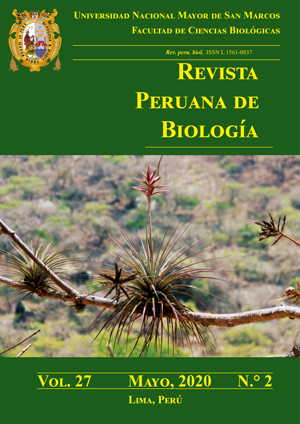Transferibilidad de marcadores microsatélites de Anas platyrhynchos al pato criollo peruano Cairina moschata domestica
DOI:
https://doi.org/10.15381/rpb.v27i2.15015Palabras clave:
Cairina mochata domestica, transferibilidad, PIC, cola M13, electroforesis capilar, SSRResumen
El pato criollo peruano (Cairina moschata domestica) es una de las especies de mayor importancia económica en la alimentación humana. Las especies de patos forman grupos genéticos complejos y difíciles de reconocer, por lo que el uso marcadores microsatélites (SSR) identificados en una especie relacionada como Anas platyrhynchos, representa una opción atractiva, de menor costo y útil para resolver temas relacionados con la conservación de la diversidad genómica, flujo génico e hibridación entre poblaciones. El objetivo de la investigación fue evaluar la transferibilidad de 24 SSR identificados para A. platyrhynchos a las poblaciones peruanas de C. moschata doméstica y determinar el grado de polimorfismo (PIC) de los marcadores transferibles. Para ello, se obtuvo ADN a partir de plumas alares usando el método cloroformo-alcohol isoamílico. Los SSR se construyeron con una secuencia adicional de 19 pb (cola M13) y se utilizaron fluoróforos 6-FAM, VIC, NED y PET para su etiquetado. Los fragmentos amplificados fueron visualizados en geles de agarosa 2% y separados por electroforesis capilar en un secuenciador automático ABI 3130XL. Los resultados mostraron 7 SSRs con un valor PIC alto (PIC>0.5) y que el marcador CMO211 se expresaba con un tamaño molecular menor del de la referencia. En conclusión, el presente trabajo demostró que el 75% de los SSR diseñados para A. platyrhynchos son transferibles a C. moschata domestica; y que sólo 7 fueron altamente informativos. Demostrando así que los SSRs son útiles en la detección de polimorfismos en especies relacionadas y pueden ser usados para mejorar las poblaciones peruanas de patos criollos.
Descargas
Descargas
Publicado
Número
Sección
Licencia
Derechos de autor 2019 Wendy Acuña Rodriguez, Claudia Esther Yalta Macedo, Eudosio Amancio Veli Rivera

Esta obra está bajo una licencia internacional Creative Commons Atribución-NoComercial-CompartirIgual 4.0.
LOS AUTORES RETIENEN SUS DERECHOS:
a. Los autores retienen sus derechos de marca y patente, y también sobre cualquier proceso o procedimiento descrito en el artículo.
b. Los autores retienen el derecho de compartir, copiar, distribuir, ejecutar y comunicar públicamente el artículo publicado en la Revista Peruana de Biología (por ejemplo, colocarlo en un repositorio institucional o publicarlo en un libro), con un reconocimiento de su publicación inicial en la Revista Peruana de Biología.
c. Los autores retienen el derecho a hacer una posterior publicación de su trabajo, de utilizar el artículo o cualquier parte de aquel (por ejemplo: una compilación de sus trabajos, notas para conferencias, tesis, o para un libro), siempre que indiquen su publicación inicial en la Revista Peruana de Biología (autores del trabajo, revista, volumen, número y fecha).






